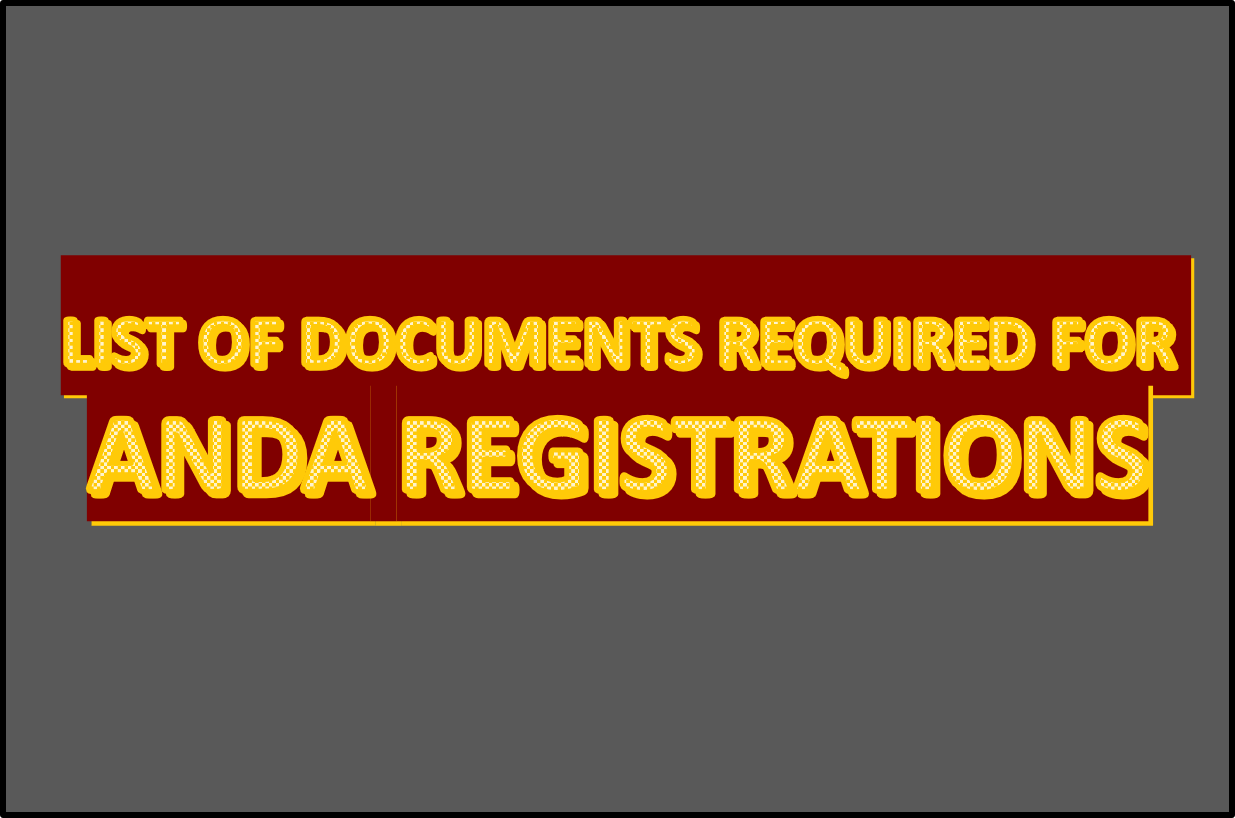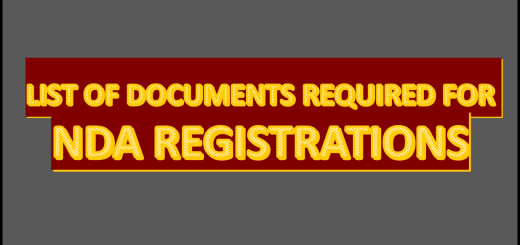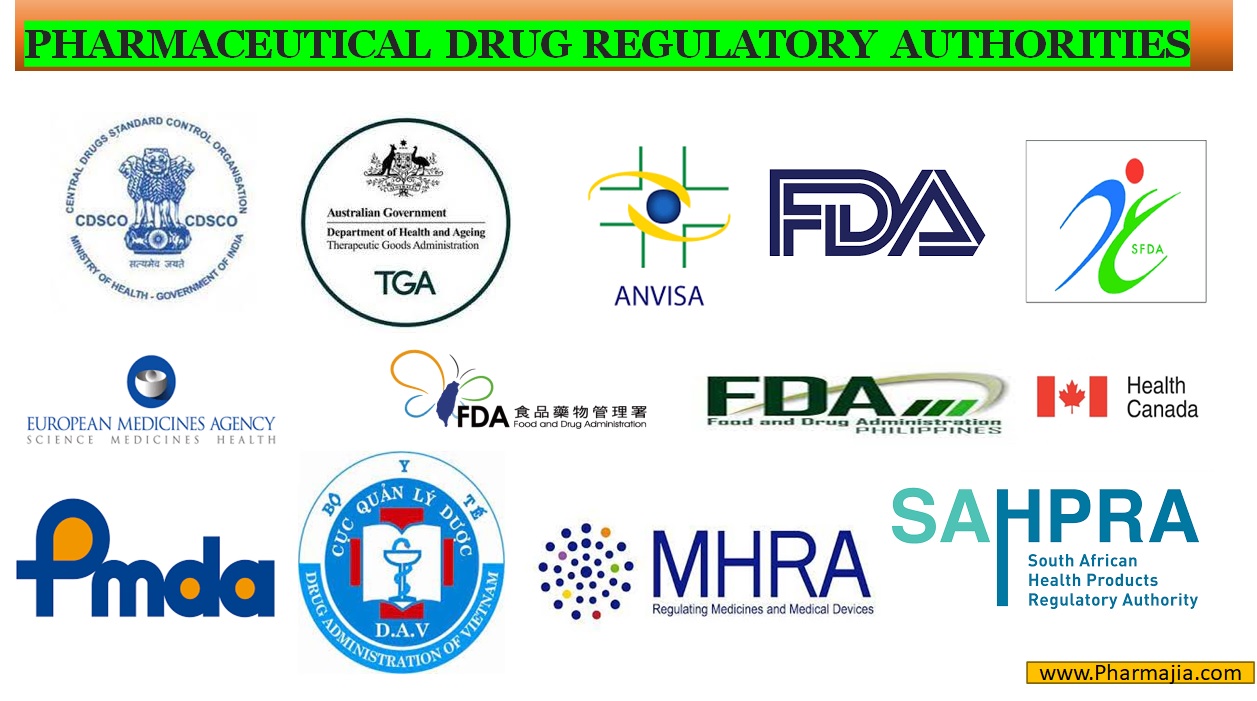List Required documents for ANDA Registration.

This article includes List of Documents Required for ANDA (Abbreviated New Drug Application) Registration.
What is mean by ANDA ?
ANDA stands for Abbreviated New Drug Application, which is a type of application submitted to the United States Food and Drug Administration (FDA) for approval of a generic drug. An ANDA is submitted by a pharmaceutical company seeking to market a generic version of a previously approved brand-name drug
The ANDA process is less expensive and less time-consuming than the approval process for a new drug application as the generic drug must demonstrate bioequivalence to the brand-name drug. in short it mean that it should be pharmaceutically equivalent in terms of its dosage form, strength, route of administration, quality, intended use Once the ANDA is approved, the generic drug can be marketed and sold in the United States.
List of Documents Required for Registrations of Abbreviated New Drug Application (ANDA) :
Below are the List of Documents Requirement for ANDA Registrations :
- Product development report
- Product history file
- Research and Development manual and PDCL
- Punch procurement letter
- Research and Development batch data along with product development report.
- Authorization for regulatory batch.
- Research and Development communication for DCI (Drug controller of India) & license application
- New bulk codes, product code, pack code, RM &PM codes application for ANDA products.
- MSDS (Material safety data sheet) for API & Excipients
- Vendor audit for API, excipients & PM
- OVI (Organic volatile impurities) statement for API & excipients
- NDC (New drug code) for tooling
- Excise formalities.
- Narcotics permission, Alcohol quota (if applicable)
- List of critical controls for environment & product.
- TSE (Transmissible spongiform Encephalopathy) free certificate
- Personnel trainings.
- Utilizes validation like Purified water, potable water, pure steam, boiler steam, compressed air etc.
- One regulatory batch to be manufactured one batch to be packed completely and retained in BSR.
- Optimum batch size should be decided on occupancy & commercial estimate as per requirement
- Exhibit batch size should be more than 1,00,000 Nos.(minimum quantity to be packed 1,00,000 Nos tablets )
- All API & excipients should be as per USP /NF if official in pharmacopoeia.
- Product name should be in generic name.
- FDA license & DCGI permission, excise formality.
- Purified water USP to be used if required.
- In case of Opadry formulation DMF No required.
- For proposing exhibit batch size optimum occupancy should be consider during selection of equipment.
- Proposal for scale up (Pre ANDA) batch, ANDA and commercial batch size.
- Batch size, cost proposal & approval
- Process flow sheet & equipment availability
- Equipment Equivalency
- Tooling Drawings: Punches and dies change parts approved drawing & availability.
- Comparative equipments chart for scale up, exhibit and proposed commercial batch.
- Pack split up & label approval from PRC & party.
- Availability of innovator sample for analysis & stability studies.
- Non toxic certificate of packing material
- Area qualification
- List of equipments and their qualification/ calibration status to be checked before taking exhibit batch.
- Equipment equivalency & preventive maintenance plan for major equipments
- Master BMR & BPR preparation & approval form PRC.
- Computer generated sticker label approved by PRC & Party.
- As per communication from PRC bio-study sample to be sent to the Lab.
- Comparison of in process checks & process parameters between scale up batch, exhibit batch and commercial batch.
- Packing material like container & closure to be released as per USP 671 (Containers performance Testing), USP 661 (Container MOC) & USP 1207 (Sterile product packing integrity evaluation)
- Biostudy pack confirmation & release.
- Techmark study with innovator product.
- Product development report.
- Batch to be kept in warehouse until final approval of ANDA & any normal holding period that has been established. After this batch should be destroyed after authorization & it should be retain along with BMR.
- Environment monitoring certificate
- GMP agreement
- Assessment protocol of exhibit batch and proposed commercial batch.
- Assessment report of exhibit batch.
- Assessment flow sheet.
- Approved supplier list and vendor list
- cGMP certificate of out side testing laboratory.
- Generic drug environment act statement.
- Brief description of manufacturing facility along with process flow sheet.
- Technical agreement with party.
- Hold time study protocol /report /data ( Binder/Blend/ Tablet/ / coating suspension/Bulk etc.)
- Product assessment summary
- Product review report
- TSE/BSE Certificates of all excipients.
- Material safety data sheet.
- Master manufacturing formula (MMF).
- Master packing formula (MPF)
- Master BMR / BPR of exhibit & commercial batch.
- cGMP certificate for API as well as finished product.
- OVI certificate of API manufacturer & excipients
- Polymorphic identity.
- Instruments required, Reagents, Columns, Reference standards, working standards and Impurity standards.
- Raw Material specification.
- Packing material specification.
- Bulk finished specification.
- Finished product specification.
- Stability finish product specification (Pre approval & post approval stability protocol).
- Residual solvents study data
- Impurity profiling
- Agreement between contract laboratory & requirement should be USFDA approved.
- (HDPE bottle, CRC caps non-CRC cap, silica gel bag, and polybag, fiber drum)
- Instruments, reagents, columns, reference standards, working standards & impurity standards with approved protocol.
- Availability of approved standards for RM, PM, finish product.
- Microbial testing requirement.
- Raw material certificate of analysis
- Finished product certificate of analysis. Blend specification,
- Approved standards of packing material.
- Packing material COA.
- PM testing as per USP661, USP671 & USP1207.
- Analytical method availability & validation for API & finish product.
- Cleaning method validation for previous product & current product (Swab, Rinse & API recovery).
- Assay (HPLC), Uniformity of dosage units, dissolution, related substances, forced degradation study.
- Analytical method validation (API): Assay, Residual solvents, related substances, force degradation studies.
- Analytical method validation (Finish product): Assay, content uniformity, Residual solvents, related substances, force degradation studies.
- API recovery study.
- API Polymorphic identity.
- Chromatography purity, assay, residual solvent, particle size, forced degradation study & other tests.
- Polymorphic identity of API (If applicable)
- Water exposure study on scale up batch (If applicable)
- Dissolution profile:
- All media (Official & non official) dissolution profile should be performed within time span of 30 days for Multimedia dissolution profile.
- Multimedia dissolution profile of only biostudy sample strength to be performed for Multi-strength product. For remaining strengths official media to be performed
- Dissolution medium sapling points & no. of units
- Working standards used in ANDA batch of API & finished product.
- Well-labeled chromatograms of identification test, related substances analysis.
- Three month stability data at room temperature and accelerated for all pack and all strength.
- Comparative profiling against innovator for dissolution in three media, content uniformity, assay with own & innovator’s product. F2 should be more than 50 % in all media
- Pre- approval and post approval stability protocol.
- Blank stability chart for all packs.
- Excipients manufacture COA’s.
- Letter of access of primary container and API.
- Stability conditions as per ICH:
- Long term: 30°C/75 RH (samples also to be incubated at 30°/65 RH and 25° C /60% RH). If significant change observed at 30 °/75% RH then samples to be analyzed at 30°C/65 RH .If significant change observed at 30°C /60% RH then only samples from 25°C/60RH condition to be monitored.
- Accelerated conditions: 40 °C /75% RH (Interval 1,2,3&6 months)
- Stress condition: 50 °C/ Ambient RH (Interval 1,2,3 months) and 25°C 80% RH (Interval 1,2,3 months).
- Stability of fire drum / bulk container should be conducted at room temperature for 6 months (official 3 months & 6 months for information)
- Force degradation study under different stress conditions.
- Ensure all drug substance and excipient component of the drug product have residual solvent acceptance limits that fall with ICH or Ensure all drug substance and excipient component of the drug product weighted by their amount in drug product and cumulative daily exposure within ICH limit. Ensure via direct testing of the drug product falls within the ICH limit.
For Details can Refer guideline “Guidance for Industry ANDA Submissions — Content and Format of Abbreviated New Drug Applications”



